7 Weird and Wonderful Christmas Traditions
Call them strange, weird, or simply unusual: These seven Christmas traditions are certainly a special gift to the world.
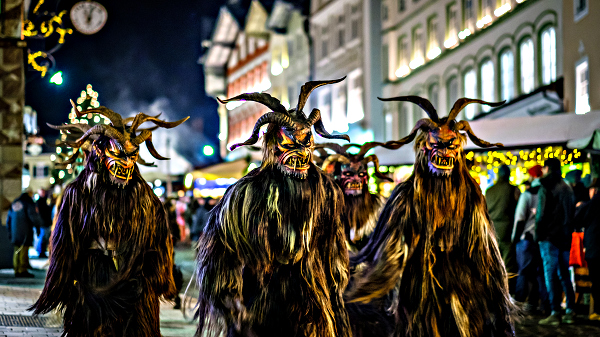
People in terrifying costumes roam the streets of alpine villages in December, representing the spirits of winter. Pictured here are the Krampus celebrations in Bad Toelz, Germany.
© iStockphoto.com/FooTToo
Advent calendar 2024: Count the days to Christmas
1. A Goat-Demon from the Mountains (Austria)
On the evening of December 5, a hairy goat demon can be seen in alpine villages throughout southern Germany, Austria, Czechia, Slovenia, and northern Italy.
Sometimes appearing as Santa’s enforcer, other times parading through the streets, Krampus is always a sight to behold: The goat-demon or mountain spirit is hairy and spikey, usually wearing goat horns and brandishing a whip or a cane he uses for flogging.
Krampus (from the old German Krampen, meaning claw) is one of many pre-Christian winter traditions incorporated into modern Christian folklore – these days, Krampus often appears at Santa’s side dishing out the punishment for naughty children.
Originally, Krampus was a winter spirit people would chase away around the winter solstice when the light returned and the new year began. This tradition is still practiced: When Krampus parades through the streets, people will try to scare him off. Children might try to chase him as a dare.
2. Christmas Poop (Catalonia)
The caganer or “pooper” appears in traditional Catalan clothing, albeit lowered around the ankles. © iStockphoto.com/Margalef-Eva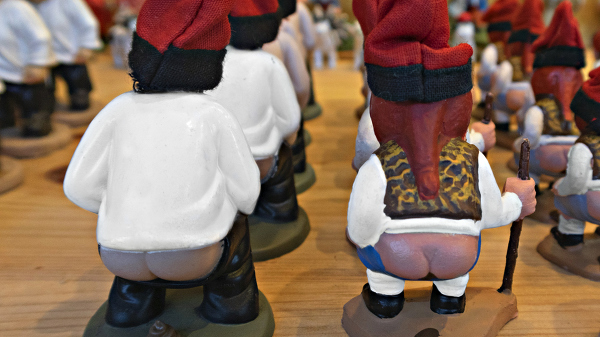
From early December until Christmas, a little figure appears in nativity displays across Catalonia in northeastern Spain: The caganer (Catalan for “the crapper”) is a man or woman in traditional Catalan clothes defecating somewhere close to the Baby Jesus.
The caganer has been around since the 17th century and remains a fixture in Catalan tradition. When the city of Barcelona decided not to include the caganer in its nativity scene in 2005, people were outraged. The caganer was quickly restored the following year.
Why a guy relieving himself is featured in the holiest of scenes remains a mystery — theories range from representing good luck and fertility to showing the human nature of the divine. Maybe it is all just a silly joke; who knows?
What we do know is that the caganer is not the only poop-themed Christmas tradition in Catalonia: Caga tió, or the pooping log, is a small wooden stick or log with a smile that children “feed” sweets and nuts during December and keep warm under a blanket. Until Christmas Eve, when they beat it with sticks until it drops their presents.
3. Carving Radishes (Mexico)
Skilled artisans craft beautiful displays from radishes in Oaxaca, Mexico. They only last half a day before the radishes wilt and fall apart. © iStockphoto.com/vichinterlang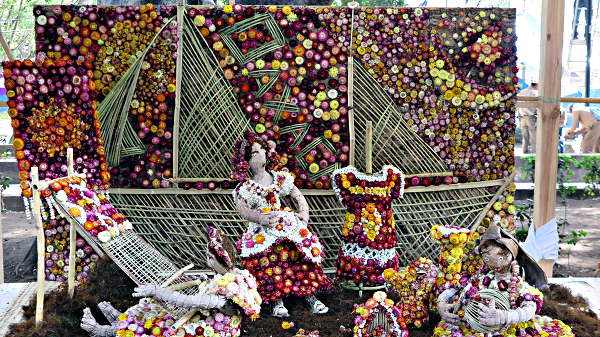
On December 23, the old city of Oaxaca in southern Mexico blooms with life: Thousands of visitors line up to see the displays of radish carvings in all the colors of the rainbow. Over a hundred competitors carve animals, architectural marvels, mythical monsters, or scenes from everyday life. All made from local radishes, the sculptures only last a few hours before they wilt.
La Noche de Rábanos (the night of radishes) started as a tradition at farmers’ markets – to stand out, farmers would start carving some of their radishes into a display. The region of Oaxaca has long been known for its wood carvings, so the talent has always been there. Since 1897, the competition has been held every year on December 23.
4. A Fashion-Critical Beast-Cat (Iceland)
In Iceland, people are happy to get socks for Christmas. You would be, too, if the alternative was ending up as a snack for the monster cat. © iStockphoto.com/Kati Lenart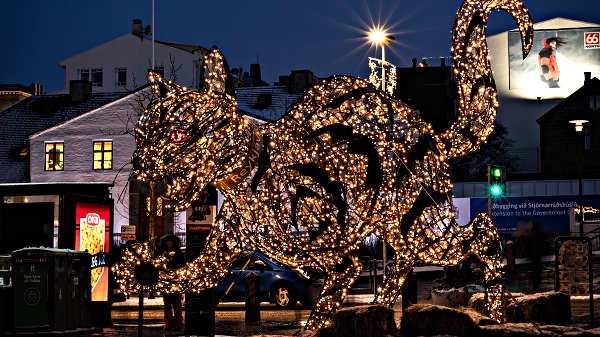
Gifts are exchanged on Christmas Eve in Iceland. But this is not the unique tradition we wanted to mention here: More interesting is the Yule Cat, a vicious monster in cat form lurking outside in the snow, waiting to pounce on everyone who didn’t receive any new clothes for Christmas.
The Yule Cat is known as Jólakötturinn in Icelandic, and a good reason to be happy with getting a sweater for Christmas. The tradition might come from farmers trying to motivate workers to spin the autumn wool into clothing before the winter break. Or it might not; it is Iceland, after all.
The fashion-critical cat is not the only beast harassing Icelandic people during Yule: Jólaköturinn belongs to the ugly giantess Grýla, who comes down from the mountains during Christmas to catch naughty children and carry them back to her cave to devour them. So maybe the cat is not so bad after all.
5. Kentucky Fried Christmas (Japan)
A typical Christmas dinner in Japan can include fried chicken and cake. © iStockphoto.com/recep-bg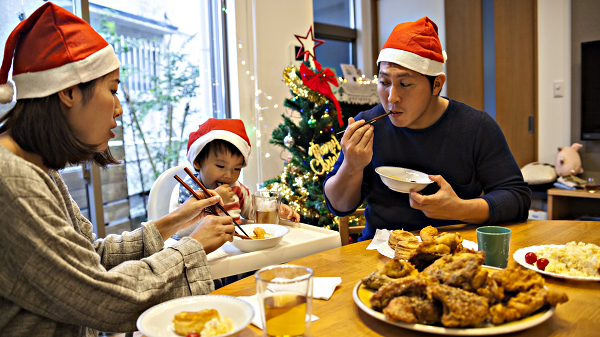
Although Japan is not a traditionally Christian country, Japanese people have been known to import many Western traditions over the years. One of the newer additions is the Christmas dinner; it is so new that it can be traced back to a marketing campaign the fast food chain Kentucky Fried Chicken ran in 1974.
Back then, neither turkey nor fried chicken was on the menu in Japanese households, and KFC set out to change that. The simple slogan “Kentucky for Christmas” (Kurisumasu ni wa kentakkii) started a tradition that thrives to this day.
Although Christmas is not an official holiday in Japan, many families sit down on December 25 with a fried chicken dinner and cake. If you think they chose a cheap option, you would be wrong – this premium chicken can set you back 40 US dollars.
6. Singing Horse Skull (Wales)
Although horse skulls are the traditional choice for the Welsh tradition of Mari Lwyd, this picture shows a cow skull. Maybe because it is easier to source? Photo by R. Fiend / CC BY-SA 3.0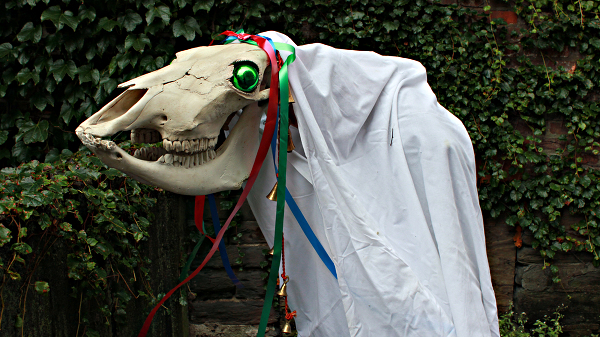
If you live in the UK’s southwest, specifically in Wales, beware of knocks on your door between Christmas and January 6. It might be a singing horse skull coming to drink all your alcohol.
Mari Lwyd is a horse’s skull on a stick, covered with colorful ribbons and a white sheet. The name Mari Lwyd likely comes from an old Welsh word for “grey mare.” The mare is usually accompanied by up to seven men, sometimes in costumes or decorated with ribbons and sashes.
Between December 24 and January 6, during the 12 days of Christmas, Mari Lwyd knocks on people’s doors and engages in a musical verse battle; both parties take turns, usually singing in rhymes until one side gives up. The horse skull tries to convince people to let it into their homes while the defender looks for reasons why right now really isn’t a good time.
This tradition, called pwngco, is an old form of a rap battle, also known as flyting – a practice well-established in Norse and Anglo-Saxon culture. When Mari Lwyd wins, the horse skull and all the attached men enter the house to eat and drink whatever they can find, while one of them keeps the house owners entertained with song and dance.
7. The Alcoholic Witch (Italy)
La Befana (here in her cutest representation) is often used as a Christmas decoration in Italian households. © iStockphoto.com/corradobarattaphotos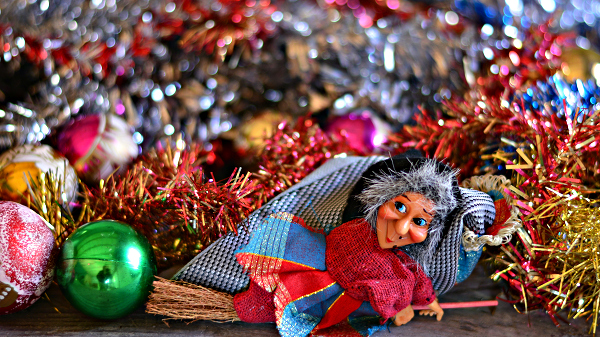
While children worldwide are waiting for one day to finally open their gifts. Children in Italy don’t have to limit themselves to only one day.
Italian children have five different Christmas characters to choose from: On December 6, San Nicolò comes with his bag of presents.
On December 13, Santa Lucia, the light-bringer, comes to children who leave out food for her and her donkey.
On December 24 and 25, Baby Jesus and Father Christmas bring gifts.
On January 5, the night before Epiphany, a witch comes flying down the chimney, rewarding good children with figs, nuts, and honey.
The witch is arguably the most interesting of the bunch: La Befana is an alcoholic witch who is chronically late and can’t find the way to Baby Jesus in Nazareth, so she visits every child in Italy instead.
Her name probably stems from La Epifania, the name for the Christian feast on January 6, traditionally connected with receiving gifts. La Befana prefers wine and sausages to milk and cookies, and she loves cleaning and punishing badly behaved children.